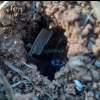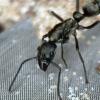All ants have some hair. Normally these hairs form an important part of the ants sensory world. They can sense vibrations and air currents. But why do some ants such as Camponotus thadeus and Camponotus fulvopilosus have ... fur?

This ant was recently photographed live in the wild for the first time. https://www.abc.net....sland/103369530
Ants are near relatives to bees, and bees use their dense setae to collect pollen. But that can't be the reason.

Camponotus fulvopilosus a South African ant.


















